View in other NatureServe Network Field Guides
NatureServe
Montana
Utah
Wyoming
Idaho
Wisconsin
British Columbia
South Carolina
Yukon
California
New York
Two-striped Grasshopper - Melanoplus bivittatus
General Description
The following is taken from Brooks (1958), Vickery and Kevan (1985), Pfadt (2002), Capinera et al. (2004), and Scott (2010). This large, robust species is so named for the two pale yellow stripes extending from the back of the eyes, across the lateral lobes of the pronotum, to the tips of the forewings. They converge to form a V-shape. On the head and pronotum, the stripes are usually bordered below with black. The wing (tegmina) length of males reach or slightly surpass the knee of the femur. Female wings are slightly shorter.
Phenology
Eggs begin to hatch in mid-spring over a 4 to 6-week period. It is an early-hatching species. Nymphs pass through 5 to 6 instars. Adults occur from late June to September or October, when they are eventually killed by frost (Capinera and Sechrist 1982, Pfadt 2002, and Scott 2010).
Diagnostic Characteristics
The following is taken from Brooks (1958), Vickery and Kevan (1985), Pfadt (2002), Capinera et al. (2004), and Scott (2010). Body length for males is 23 to >28 mm, females 29 to 45 mm. Color is variable from tan, brownish or greenish. Outer surface of the hind femur has a dark stripe on its upper half and yellow on the lower. The hind tibia can be bluish green, blue, or poppy red with black spines.
Among the
Melanoplus, it is easy to identify. The Two-striped Grasshopper is one of two of the largest species in the genus. The other is the
Differential Grasshopper (
M. differentialis).
Species Range
Montana Range
Range Descriptions
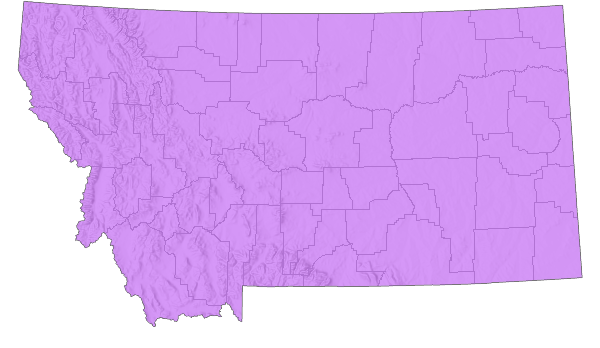
 Native
Native
Range Comments
Very widely distributed across North America. It occurs in all the Canadian provinces, and every U.S. state except Florida. In Montana, it is abundant and common in all 56 counties (Vickery and Kevan 1985, Pfadt 2002, Capinera et.al. 2004, and Scott 2010).
Observations in Montana Natural Heritage Program Database
Number of Observations: 110
(Click on the following maps and charts to see full sized version)
Map Help and Descriptions
Relative Density
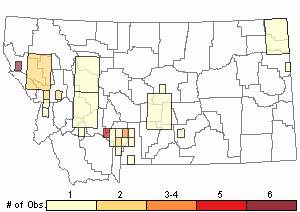
Recency
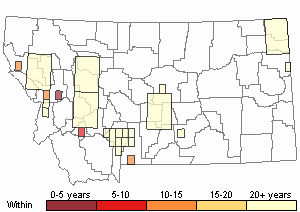
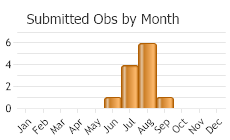

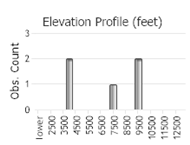 (Observations spanning multiple months or years are excluded from time charts)
(Observations spanning multiple months or years are excluded from time charts)
Habitat
This species is highly adaptable and occupies many habitat types. It prefers habitats with lush vegetation, but is also associated with disturbed sites along roadsides, field borders, gardens, and agricultural sites (Vickery and Kevan 1985, Pfadt 2002, Capinera et al. 2004, and Schell et al. 2005).
Food Habits
The Two-striped Grasshopper is polyphagous, feeding on a vast diversity of grasses, forbs, trees, shrubs, and many cultivated plants. It seems to prefer, and need, forbs because it seems to do physically poor in their absence. The host food plants include several families, such as mustards, fixweed, pepperweed, plantain, alfalfa, red clover, sunflowers, prickly lettuce, sow thistle and many more composites of the Asteracae (Pfadt 2002, Capinera and Sechrist 1982, Capinera et al. 2004, and Schell et al. 2005).
Reproductive Characteristics
Grasshoppers that have moved into crops return to field borders and roadsides for reproduction, where the soils are hard and compacted. Irrigated fields of alfalfa are also attractive oviposition sites, as are south-facing ditch banks. Egg laying occurs from mid-August to mid-October, depending upon frost occurrences. Females select crowns of grass or roots of weeds for egg laying. They generally deposit 1 to 2 pods, containing 43 to 135 eggs arranged in columns of four per pod (Capinera and Sechrist 1982, and Pfadt 2002).
Management
The following is taken from Pfadt (2002) and Schell et al. (2005). The Two-striped Grasshopper is known for its periodic outbreaks and a major crop pest of alfalfa, small grains and corn. During outbreaks, it may completely destroy crops. It is also a common pest defoliator of garden plants, vegetables, trees and shrubs in suburban areas.
It is believed that this species became a serious pest when early settler agricultural development unknowingly sowed various weed seeds with their crops. These, now, invasive species grew along crop borders, roadsides, and irrigation ditch banks, creating ideal habitats for egg laying sites, especially along south-facing ditch banks and compact soils at field margins.
Stewardship Responsibility
References
- Literature Cited AboveLegend:
 View Online Publication
View Online Publication Capinera, J.L. and T.S. Sechrist. 1982. Grasshoppers of Colorado: Identification, Biology, and Management. Fort Collins, CO: Colorado State University Experiment Station, Bulletin 584S. 161 p.
Capinera, J.L. and T.S. Sechrist. 1982. Grasshoppers of Colorado: Identification, Biology, and Management. Fort Collins, CO: Colorado State University Experiment Station, Bulletin 584S. 161 p. Capinera, J.L., R.D. Scott, and T.J. Walker. 2004. Field Guide to Grasshoppers, Katydids, and Crickets of the United States. Ithaca, NY. Cornell University Press.
Capinera, J.L., R.D. Scott, and T.J. Walker. 2004. Field Guide to Grasshoppers, Katydids, and Crickets of the United States. Ithaca, NY. Cornell University Press. Hebard, M. 1928. The Orthoptera of Montana. Proceedings of the Academy of Natural Sciences of Philadelphia, Vol. 80:211-306.
Hebard, M. 1928. The Orthoptera of Montana. Proceedings of the Academy of Natural Sciences of Philadelphia, Vol. 80:211-306. Pfadt, R.E. 2002. Field Guide to Common Western Grasshoppers, 3rd edition. Laramie, WY: Wyoming Agricultural Experiment Station, Bulletin 912, modified by S. Schell and S. Schell for electronic publication. Accessed 19 February 2020. http://www.uwyo.edu/entomology/grasshoppers/field-guide/index.html#fieldguidetoc
Pfadt, R.E. 2002. Field Guide to Common Western Grasshoppers, 3rd edition. Laramie, WY: Wyoming Agricultural Experiment Station, Bulletin 912, modified by S. Schell and S. Schell for electronic publication. Accessed 19 February 2020. http://www.uwyo.edu/entomology/grasshoppers/field-guide/index.html#fieldguidetoc Schell, S.P., A.V. Latchininsky, and B.A. Shambaugh. 2005. Common Wyoming Pest Grasshoppers. 2nd Edition B-1161.Laramie, WY: University of Wyoming Cooperative Extension Service and Department of Renewable Resources. 76 p.
Schell, S.P., A.V. Latchininsky, and B.A. Shambaugh. 2005. Common Wyoming Pest Grasshoppers. 2nd Edition B-1161.Laramie, WY: University of Wyoming Cooperative Extension Service and Department of Renewable Resources. 76 p. Scott, R.D. 2010. Montana Grasshoppers, Katydids, and Crickets A Pictorial Field Guide to the Orthoptera. MagpieMTGraphics, Billings, MT.
Scott, R.D. 2010. Montana Grasshoppers, Katydids, and Crickets A Pictorial Field Guide to the Orthoptera. MagpieMTGraphics, Billings, MT. Vickery, V. R. and D. K. M. Kevan. 1985. The grasshopper, crickets, and related insects of Canada and adjacent regions. Biosystematics Research Institute, Ottawa, Ontario. Publication Number 1777. 918 pp.
Vickery, V. R. and D. K. M. Kevan. 1985. The grasshopper, crickets, and related insects of Canada and adjacent regions. Biosystematics Research Institute, Ottawa, Ontario. Publication Number 1777. 918 pp.
- Additional ReferencesLegend:
 View Online Publication
View Online Publication
Do you know of a citation we're missing? Anderson, N.L. 1951. Field studies on the biology of range grasshoppers of southeastern Montana. M.Sc. Thesis. Bozeman, Montana: Montana State University. 96 p.
Anderson, N.L. 1951. Field studies on the biology of range grasshoppers of southeastern Montana. M.Sc. Thesis. Bozeman, Montana: Montana State University. 96 p. Anderson, N.L. 1962. Grasshopper-vegetation relationships on Montana grasslands. Ph.D Dissertation. Bozeman, Montana: Montana State University. 73 p.
Anderson, N.L. 1962. Grasshopper-vegetation relationships on Montana grasslands. Ph.D Dissertation. Bozeman, Montana: Montana State University. 73 p. Bland, R.G. 2003. The Orthoptera of Michigan—Biology, Keys, and Descriptions of Grasshoppers, Katydids, and Crickets. East Lansing, MI: Michigan State University Extension, Bulletin E-2815. 221 p.
Bland, R.G. 2003. The Orthoptera of Michigan—Biology, Keys, and Descriptions of Grasshoppers, Katydids, and Crickets. East Lansing, MI: Michigan State University Extension, Bulletin E-2815. 221 p. De Smet-Moens, H. 1982. The insect fauna of Canada Thistle Cirsium arvense (L.) Scop in southern Montana. M.Sc. Thesis. Bozeman, MT: Montana State University. 51 p.
De Smet-Moens, H. 1982. The insect fauna of Canada Thistle Cirsium arvense (L.) Scop in southern Montana. M.Sc. Thesis. Bozeman, MT: Montana State University. 51 p. Gillespie, R.L.1992. Dynamics of grasshoppers (Orthoptera: Acrididae) at a rangeland-crop interference. Ph.D. Bozeman, MT: Montana State University. 111 p.
Gillespie, R.L.1992. Dynamics of grasshoppers (Orthoptera: Acrididae) at a rangeland-crop interference. Ph.D. Bozeman, MT: Montana State University. 111 p. Henry, J.E. 1969. Protozoan and viral pathogens of grasshoppers. Ph.D. Dissertation. Bozeman, MT: Montana State University. 153 p.
Henry, J.E. 1969. Protozoan and viral pathogens of grasshoppers. Ph.D. Dissertation. Bozeman, MT: Montana State University. 153 p. Kirk, K. and C.R. Bomar. 2005. Guide to the grasshoppers of Wisconsin. Madison, WI: Wisconsin Department of Natural Resources, Bureau of Integrated Science Services PUB-SS-1008. 154 p.
Kirk, K. and C.R. Bomar. 2005. Guide to the grasshoppers of Wisconsin. Madison, WI: Wisconsin Department of Natural Resources, Bureau of Integrated Science Services PUB-SS-1008. 154 p. Kreasky, J.B. 1960. Studies on a growth factor in lettuce, Lactuca sativa var. romana Hort., required by the grasshoppers Melanoplus bilituratus (Wlk.) and M. bivittatus (Say). Ph.D. Dissertation. Bozeman, Montana: Montana State University. 61 p.
Kreasky, J.B. 1960. Studies on a growth factor in lettuce, Lactuca sativa var. romana Hort., required by the grasshoppers Melanoplus bilituratus (Wlk.) and M. bivittatus (Say). Ph.D. Dissertation. Bozeman, Montana: Montana State University. 61 p. Larson, D.P. 1996. Evaluation of sweep sampling as a method for determining grasshopper community composition on rangeland. M.Sc. Thesis. Bozeman, MT: Montana State University. 92 p.
Larson, D.P. 1996. Evaluation of sweep sampling as a method for determining grasshopper community composition on rangeland. M.Sc. Thesis. Bozeman, MT: Montana State University. 92 p. Riegert, P.W. 1948. The field biology of Camnula pellucida Scud. M.Sc. Thesis. Bozeman, MT: Montana State University. 69 p.
Riegert, P.W. 1948. The field biology of Camnula pellucida Scud. M.Sc. Thesis. Bozeman, MT: Montana State University. 69 p. Sater, S. 2022. The insects of Sevenmile Creek, a pictorial guide to their diversity and ecology. Undergraduate Thesis. Helena, MT: Carroll College. 242 p.
Sater, S. 2022. The insects of Sevenmile Creek, a pictorial guide to their diversity and ecology. Undergraduate Thesis. Helena, MT: Carroll College. 242 p. Skinner, K.F. 1995. Plant and grasshopper community composition: indicators & interactions across three spatial scales. M.Sc. Thesis. Bozeman, MT: Montana State University. 144 p.
Skinner, K.F. 1995. Plant and grasshopper community composition: indicators & interactions across three spatial scales. M.Sc. Thesis. Bozeman, MT: Montana State University. 144 p. Van Horn, S.N. 1963. The embryogenesis and embryonic variability of Aulocara elliotto Thomas (Acrididae Orthoptera). Ph.D. Dissertation. Bozeman, MT: Montana State University. 172 p.
Van Horn, S.N. 1963. The embryogenesis and embryonic variability of Aulocara elliotto Thomas (Acrididae Orthoptera). Ph.D. Dissertation. Bozeman, MT: Montana State University. 172 p. Wachter, D.H. 1995. The ecology of selected grasshopper species along an elevational gradient. M.Sc. Thesis. Bozeman, Montana: Montana State University. 59 p.
Wachter, D.H. 1995. The ecology of selected grasshopper species along an elevational gradient. M.Sc. Thesis. Bozeman, Montana: Montana State University. 59 p.
- Web Search Engines for Articles on "Two-striped Grasshopper"
- Additional Sources of Information Related to "Insects"





